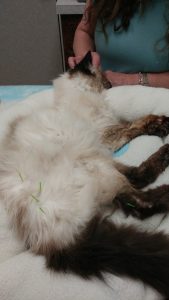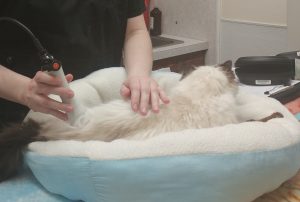Written by a CuraCore Veterinary Medical Acupuncture course graduate. Signed release obtained from client/author.
Abstract: A geriatric male neutered cat presented for complaint of deteriorating mobility and poor quality-of-life despite a combination of anti-inflammatories and joint supplements. A treatment schedule of four sessions of dry needling acupuncture and photomedicine was instituted over a four week period. Mobility and quality-of-life improvements were noted by the client after the second session.
History of Present Illness and Chief Complaints:
An approximately 16 year old male neutered 3.5 kilogram Siamese mix named “Milo” was presented for complaints of osteoarthritis (OA) and decreased quality-of-life (QOL). Milo was rescued by the client approximately 6 years ago from the local shelter. He has a history of chronic suspect herpes virus infections of the right eye, which typically resolves with antibacterial ophthalmic support and time, prior to the client adopting him. His primary care veterinarian started Milo on meloxicam in August 2018 as well as the glucosamine chondroitin joint supplement Dasuquin Advanced after complaints of decreased mobility, inability or unwillingness to stand during eating, and decreased interactions with other family members. Routine senior wellness bloodwork showed appropriate kidney and liver values for starting a non-steroidal anti-inflammatory (NSAID). The meloxicam was started at 0.05 mg/kg dosing once daily for 1 week and then decreased to 0.025 mg/kg daily for arthritis comfort. The client reported a perceived increase in Milo’s comfort and mobility. Bloodwork was rechecked 4 weeks later and showed a mild increase in BUN and creatinine values (59 mg/dL and 2.0 mg/dL respectively). The meloxicam dosing was decreased to every 48 hours and blood values were rechecked 8 weeks later to show slight increases in renal values again (52 mg/dL and 2.2 mg/dL). The meloxicam was decreased further to every 72 hours. Milo’s mobility was reported to be decreased as the NSAID dosing frequency decreased. Acupuncture and photomedicine were then offered to help improve Milo’s QOL and mobility as well as limit stress on his renal function with NSAIDs.
Physical Examination and Clinical Assessments:
On examination the patient was quiet, alert, and responsive. Body condition score was considered under ideal, level 1, according to the WSAVA scoring system. Temperature, heart rate, and respiration were all within normal limits. Ophthalmic exam revealed a healed corneal ulceration on the right eye. Cranial nerves were intact. Abdominal palpation revealed no abnormalities. Fur quality and condition were poor, with several areas of matting and seborrhea. Myofascial exam revealed severe muscle loss, generalized, graded as 3/3 by WSAVA scoring system. Muscle tension was noted in the lumbar vertebral region as well as Milo’s range of motion (ROM) of his stifles and hips were subjectively decreased, with patient discomfort noted when performed. The patient was placed on the floor to observe mobility and placement of limbs; he remained lying in the same spot and would not attempt to get up and move around. Food enticements and owner encouragement were not successful. On neurologic exam, Milo’s conscious proprioceptive reflexes were deemed initially decreased in the hindlimbs but repeatable, consistent results varied. Cutaneous sensation and deep pain were intact. Crossed extensor reflex was present and repeatable.
Problem List:
1. Decreased range of motion and mobility
2. Severe muscle loss
3. Crossed extensor reflex positive
4. Possible decreased proprioceptive reflexes
5. Chronic kidney disease, IRIS Stage 2
6. Corneal scarring, right eye
7. Poor body condition
8. Unkempt fur appearance and quality
Differential Diagnoses List:
1. Decreased mobility
a. Vascular – fibrocartilaginous embolism
b. Infectious/inflammatory – osteoarthritis, upper motor neuron disease
c. Neoplastic – spinal lymphoma
d. Iatrogenic/intoxication – disuse atrophy
e. Congenital – hip dysplasia, muscular dystrophy
f. Autoimmune – feline chronic progressive polyarthritis
g. Traumatic – injury by housemate, falling due muscle mass loss
h. Endocrine/metabolic – lethargy secondary to chronic kidney disease
i. Myofascia – epaxial muscle tension
2. Muscle loss
a. Vascular – fibrocartilaginous embolism, cardiac cachexia
b. Infectious/inflammatory – osteoarthritis, upper motor neuron disease, toxoplasmosis
c. Neoplastic – spinal lymphoma
d. Iatrogenic/intoxication – disuse atrophy secondary to osteoarthritis, non-steroidal anti-inflammatory overdose exacerbating kidney disease
e. Congenital – glycogen storage disease, muscular dystrophy
f. Autoimmune – disuse atrophy secondary to polyarthritis
g. Traumatic – injury by housemate
h. Endocrine/metabolic – chronic kidney disease, hyperthyroidism, diabetes mellitus
i. Myofascia – disuse atrophy
Definitive Diagnoses:
The definitive diagnosis for Milo was muscle atrophy due to disuse secondary to osteoarthritis as well as chronic kidney disease. His bloodwork supported some early kidney function impairment as well as ruled out any thyroid or other endocrine (diabetes mellitus) problems. His osteoarthritis was considered inflammatory (degenerative) though autoimmune could not be completely ruled out; radiographs were offered but declined by the client. Due to Milo being initially treated for mobility problems for approximately a year before starting integrative methods, more severe causes such as vascular, traumatic, and neoplastic differentials were considered much less likely as they typically are acute presentations and continue to worsen despite therapy. Milo also had no history or evidence on physical exam of cardiac disease.
Medical Decision Making:
Since Milo’s mobility problems at home seem to be mostly centered on his hindend and his physical exam showed most of his discomfort at his hips and stifles, the acupuncture treatment plan created for Milo was centered on his lower back, hips, and stifles. Due to Milo’s severe muscle wasting, dry needling acupuncture as well as LASER therapy was chosen for the approach. The acupuncture points chosen were for local stimulation of muscle trigger points as well as nerves that would reinforce proprioception and improve hindlimb function. The LASER was used to stimulate muscle trigger points too uncomfortable or deemed unsafe to needle due to lack of muscle as well as provide extra stimulation to the points already dry needled.



Medical Acupuncture and Related Techniques Used:
Milo’s treatment plan consisted of four sessions, initially twice a week for the first week but then once weekly for the last two sessions due to client schedule. A fleece blanket and cat bed were sprayed with Feliway pheromones 10 minutes prior to appointments and used for each treatment session. SEIRIN J-15 0.14 mm gauge needles were used for all dry needling acupuncture sessions and SEIRIN J-Type 0.18 mm gauge needles were used for GV20 only. Each point was stimulated between 10 – 20 minutes, based on Milo’s comfort each session. Point selection was based on local and central neuromodulatory capability. GV20 was selected as the main relaxation point, stimulating the trigeminal and cranial cervical spinal nerve convergence and induce a sedative like affect. Points along the inner Bladder line such as in the region of BL25 were chosen based on Milo’s myofascial exam and the discomfort/tension noted. Needles were placed at trigger points noted in the epaxial muscles adjacent to L6. Bladder 54 was chosen for its applications in hip pain, along with GB29 and GB30. Bladder 60 was initially chosen as a point for spinal/pelvic limb pain but was discontinued as Milo did not allow for continued placement of the area and consistently shook the needle free. Bai hui was chosen for its lumbar spinal nerve stimulation for local tender points as well as pelvic limb dysfunction. A Companion Class IV CTC LASER was used to treat each area of dry needling stimulation. The settings were set for Milo’s appropriate weight class, thin body and muscle condition, arthritis preset, and affected body areas (coxofemoral, stifle, lumbar spine). A 2 watt, 336 Joules total was used to treat the areas listed for each session.
Outcomes:
Milo was reassessed at the end of session four, four weeks after starting acupuncture and LASER therapy. He still had some decreased ROM in hips and stifles but was more accepting of the exam than previously. His reflexes remained the same. When placed on the floor, Milo readily got up and walked across the exam room to get in his cat carrier, which was an improvement over his initial exam findings. The client reported seeing Milo curled asleep on the bed, starting after session two; a behavioral finding the client reported he had not done in years. He was also starting to follow the client into the kitchen for food, instead of it being delivered to him, and was standing up for short periods while eating. The client reported that subjectively Milo seemed more comfortable and less stiff in his day to day activities, an improved in his QOL.
Discussion and Insights:
Based on the client’s report of Milo’s activities at home, the combined sessions of acupuncture and LASER were helpful in managing his musculoskeletal discomfort and tension from osteoarthritis and muscle atrophy. It also allowed him to keep the meloxicam dosage low, minimizing renal function impairment. Osteoarthritis is one of the top disease processes with successful treatment and pain relief treatment in humans as well as pets. There is significant reduction in pain and improvement in mobility, thus improvement in QOL. In Milo, due to his geriatric state and fragility, it was difficult to assess him initially but the client reports of seeing behaviors not seen in years was a qualitative success. In the future, having clients record activities at home prior to assessing in the clinic may give more insight to specific areas needing treatment in cats, as they tend to be much more reserved in the clinical setting. This is a good combination therapy to add to traditional means of treating osteoarthritis pain that is low risk on organ function and minimally invasive. Adding low-frequency electrical simulation to his sessions over a longer period of time could have helped stop or potentially reverse the muscle atrophy process induced by his chronic kidney disease. Unfortunately Milo was euthanized shortly after his fourth treatment session due to suspected acute worsening of his kidney failure.
References:
1. Curacore Integrative Medicine and Education Center. Medical Acupuncture for Veterinarians:Canine Point Mini-Manual.
2. Li Hu, Janet D. Klein, Faten Hassounah, Hui Cai, Cong Zhang, Ping Xu and Xiaonan H. Wang. Low-Frequency Electrical Stimulation Attenuates Muscle Atrophy in CKD—A Potential Treatment Strategy. JASN March 2015, 26 (3) 626-635; DOI: https://doi.org/10.1681/ASN.2014020144
3. Min-Su Kim, Tchi-Chou Nam. Electroencephalography (EEG) Spectral Edge Frequency for Assessing the Sedative Effect of Acupuncture in Dogs. Journal of Veterinary Medical Science. 2006, Volume 68, Issue 4, p. 409-411.
4. Manyanga, Taru et al. Pain Management with Acupuncture in Osteoarthritis: a Systematic Review and Meta-Analysis. BMC Complementary and Alternative Medicine, 14, Article number: 312 (2014).